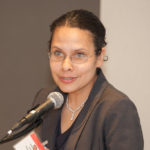A panel of experts on access to a quality K-12 education gathered to discuss solutions.
By Casey Quinlan, Education reporter at ThinkProgress —

iStockPhoto
Students of color have less access to gifted and talented programs than white kids do for a variety of reasons, from simply not having the programs at their schools to teachers failing to identify gifted students of color.
Racial and economic segregation of schools, harsh student discipline approaches, and racial bias on the part of teachers all play a role in creating this gap, expert panelists explained on Tuesday at a Center for American Progress event focusing on improving access to gifted programs for students of color. (Disclosure: ThinkProgress is an editorially independent publication housed at the Center for American Progress.)
“A black student’s odds of getting into one of these programs is 66 percent lower than for a white student.”
A black student’s odds of getting into one of these programs is 66 percent lower than it is for a white student, according to a study published this year by AREA Open, a peer-reviewed publication of the American Educational Research Association. Latino students also don’t fare as well as white students, as their odds are 47 percent lower.
These inequities are also clear when you look at the number of students of color in gifted and talented programs versus the total number of students of color. Hispanic students are 24 percent of the student population but only 17 percent of students in these programs. Black students make up 16 percent of total students but 9 percent of kids enrolled in gifted and talented programs.
Panelists agreed that all students should have teachers who want strive to sharpen their talents — and that schools and policymakers could make changes to help ensure that more students of color have access to these opportunities.
A legacy of racial bias in gifted education
In fact, there is a history of white people using gifted and talented programs to resist integration of schools, especially in the ’70s and ’80s, panelists said. Black students are less likely to be accepted into gifted programs than white students, even when their test scores are the same.
Lauren Mims, the assistant director of the White House Initiative on Educational Excellence for African Americans, highlighted this important detail at Tuesday’s event.
“When you’re thinking about the formation of gifted education, it does have history and roots in a lot of the principles that said black people were inferior and unintelligent,” Mims said.
“I’ve seen white youth get chapter books and black youth get a regular book.”
Mims said she is worried that if schools simply allow teachers to assort by ability into small groups, racial bias will affect how students are sorted. She cited an example where two boys in the same course who were on the same reading level were provided different books.
“When I’ve worked with youth, I’ve seen white youth get chapter books and black youth get a regular book,” she said. “That makes me nervous.”
Raising expectations for all students
Mims added that she noticed how a difference in expectations for students changed their engagement level in school when she wrote her thesis at Tufts University. Mims developed an eight-week program for 10th and 11th grade girls, called Girls Rising Above Circumstances to Excel.
“My thought was if we put children with a 1.5 GPA in a program and tell them it’s a gifted program, because I believe that they have incredible potential — even just coming with that framework instead of ‘The reason you’re here is because you have a 1.5 GPA and you’re at risk’ would change things,” Mims said. “All of a sudden students started coming to school more often, they started doing their homework, and they started telling me that they would go to the classroom and they would know that they had somebody on the side.”
She shared students’ previous experiences with teachers, where teachers asked, “Why are you here?” and, in one case, refused to give a student homework under the assumption that she wouldn’t complete it anyway.
Hannah Doruelo said she had a similar experience through the POSSE Foundation. Doruelo is a POSSE Scholar, which means the foundation chose her along with other public high school students because she has high leadership and academic potential but may have been overlooked by traditional college selection processes.
Doruelo said the POSSE Scholar program effectively flips the script on what qualities a person needs to be considered successful by considering community interaction and leadership qualities.
“Research documents show that students from communities of color tend to learn best when they’re in communal setting, not stressing individual success but a cohort or a posse, so we talked about how our specific lived experiences and family histories were assets to our education,” she said. “It’s a holistic approach to education and takes what has traditionally been a deficit like class or immigrant background and saying ‘Hey, that diversity is an asset … re-narrating what is good and bad.”
Craig Robinson, National Director of KIPP Through College, which helps students at KIPP charter schools prepare for college, agreed that high expectations are important, which is why KIPP has encouraged students to apply to more colleges. Now 53 percent of KIPP students are applying to highly selective schools. Robinson also added that dividing students by ability or as some educators call it, “tracking students,” ensures that students who may develop certain talents later in school will be written off early in their school career, and serves to make them self-conscious about their potential for academic success.
“We have to help you develop your passion, purpose, and plan.”
“We have one designation and that is that you’re a KIPPster. You’re a student at this school. We have to help you develop your passion, purpose, and plan,” Robinson said. “[Separating students] misses out on a whole set of opportunities that students will have or haven’t cultivated yet but could develop.”
How to ensure all students realize their potential
During Tuesday’s event, Mims noted that all of the subjects panelists were discussing — zero tolerance student discipline, over-representation of students of color in special education, and under-representation of students of color in gifted education — are all connected, and that one issue can’t be solved without addressing the others.
She noted that universal screening is one way to ensure greater equity in gifted and talented programs. Broward County School District in Fort Lauderdale, Florida, has taken this approach, for example. A 2015 National Bureau of Economic Research paper by David Card and Laura Giuliano found that when a school system — which may have been Broward — changed their screening process to universal screening, without any changes in standards for gifted eligibility, it led to large increases in the number of students of color and economically disadvantaged students accepted into the program.
Cherry Mullaguru, special assistant for the education policy team at the Center for American Progress, outlined a few ways to ensure that students of color have an equal opportunity to be challenged and develop all of their talents at school.
She wrote that steps such as ending teacher and parent referrals to reduce the effect of racial and class bias on selection, promoting personalized learning, reducing excessive student discipline, and directing students to apply for a range of colleges — including more selective schools — would improve opportunities for students of color. Mullaguru also emphasized the importance of ensuring curricula reflects the racial, ethnic, and cultural diversity of the students and recruiting more teachers of color.
Thanks to Tara Culp-Ressler.










